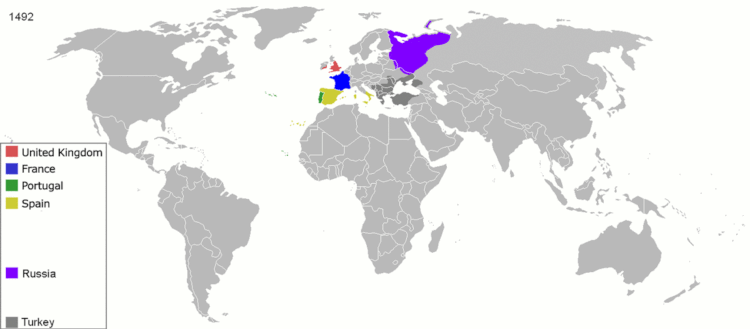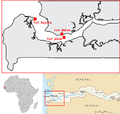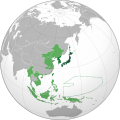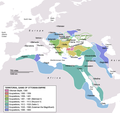Which Islamic Empire Controlled Territory In Europe During The Early Modern Era?
A colonial empire is a collective of territories (often chosen colonies), either contiguous with the imperial eye or located overseas, settled by the population of a certain state and governed by that state.
Earlier the expansion of early modern European powers, other empires had conquered and colonized territories, such every bit the Romans in Iberia, or the Chinese in what is now southern China. Modern colonial empires first emerged with a race of exploration between the then virtually advanced European maritime powers, Portugal and Espana, during the 15th century.[i] The initial impulse behind these dispersed maritime empires and those that followed was trade, driven past the new ideas and the capitalism that grew out of the European Renaissance. Agreements were also made to divide the world upwardly between them in 1479, 1493, and 1494. European imperialism was born out of contest between European Christians and Ottoman Muslims, the latter of which rose upward speedily in the 14th century and forced the Spanish and Portuguese to seek new trade routes to Republic of india, and to a lesser extent, China.
Although colonies existed in classical antiquity, peculiarly amidst the Phoenicians and the Ancient Greeks who settled many islands and coasts of the Mediterranean Bounding main, these colonies were politically independent from the city-states they originated from, and thus did not constitute a colonial empire.[2] This paradigm shifted by the time of the Ptolemaic Empire, the Seleucid Empire, and the Roman Empire.
History [edit]
European colonial empires [edit]
Portugal began establishing the first global trade network and i of the outset colonial empires[3] [four] under the leadership of Henry the Navigator. The empire spread throughout a vast number of territories distributed across the globe (particularly at one time in the 16th century) that are now parts of 60 unlike sovereign states. Portugal would eventually control Brazil, territories such as what is now Uruguay and some line-fishing ports in due north, in the Americas; Republic of angola, Mozambique, Portuguese Guinea, and São Tomé and Príncipe (among other territories and bases) in the Due north and the Subsaharan Africa; cities, forts or territories in all the Asian Subcontinents, as Muscat, Ormus and Bahrain (amongst other bases) in the Persian Gulf; Goa, Bombay and Daman and Diu (amongst other coastal cities) in India; Portuguese Ceylon; Malacca, bases in Southeast Asia and Oceania, as Makassar, Solor, Banda, Ambon and others in the Moluccas, Portuguese Timor; and the granted entrepôt-base of Macau and the entrepôt-enclave of Dejima (Nagasaki) in East asia, amongst other smaller or brusque-lived possessions.

The territorial evolution of modernistic colonial empires and some of their successor states (such as USSR, Turkey)
During its Siglo de Oro, the Castilian Empire had possession of Mexico, Due south America, the Philippines, all of southern Italy, a stretch of territories from the Duchy of Milan to the Netherlands, Luxembourg, and Kingdom of belgium, parts of Burgundy, and many colonial settlements in the Americas, Africa, and Asia. Possessions in Europe, Africa, the Atlantic Ocean, the Americas, the Pacific Ocean, and East asia qualified the Castilian Empire as attaining a global presence. From 1580 to 1640 the Portuguese Empire and the Spanish Empire were conjoined in a personal union of its Habsburg monarchs during the period of the Iberian Union, merely beneath the highest level of authorities, their separate administrations were maintained.
Subsequent colonial empires included the French, English, Dutch and Japanese empires. Past the mid-17th century, the Tsardom of Russian federation, connected subsequently as the Russian Empire and the Soviet Union, became the largest face-to-face state in the world, and the modernistic Russian Federation continues to be so to this 24-hour interval. Russia today has nine time zones, stretching across about half of the world'due south longitude.
Throughout the 19th and early on 20th century, past virtue of its technological and maritime supremacy, the British Empire steadily expanded to become by far the largest empire in history; at its pinnacle ruling over a quarter of the Earth'south state area and 24% of the population. Great britain's role as a global hegemon during this time ushered in a century of "British Peace", lasting from the end of the Napoleonic Wars to the showtime of WW1. During the New Imperialism, Italy and Deutschland also built their colonial empires in Africa.
Information technology is worth noting that, from the 16th to 19th century, at that place were besides large non-European empires, almost notably the Qing Empire of Communist china, which conquered a huge surface area of East and Inner Asia, and the states of the Historic period of the Islamic Gunpowders, Mughal India, the Ottoman Empire in Asia Minor and Southwest Europe, and Safavid Iran. The British replaced the Mughals in Republic of india, and after the Boxer Rebellion in 1901, Majestic China fabricated concessions to the Eight-Nation Alliance (all the Great Powers of the time). By the stop of the 20th century well-nigh of the previous colonial empires had been decolonized, though the modern nation-states of Russian federation and China inherited much of the territory of the Romanov and Qing empires, respectively.
Timeline [edit]
The nautical chart below[ original inquiry? ] shows the span of some European colonial empires.
- Black lines mark the year of the empires largest territorial extent of land surface area.
- Cherry-red represents that the empire is at that time a monarchy.
- Blue represents that the empire is at that time a republic.

List of colonial empires [edit]
European :
-
 Danish Empire (1620–1979/present)
Danish Empire (1620–1979/present)
-
 German Empire (1884–1920)
German Empire (1884–1920)
-
 Italian Empire (1882–1960)
Italian Empire (1882–1960)
-
 Portuguese Empire (1415–1999)
Portuguese Empire (1415–1999)
-
 Russian Empire (1721–1917)
Russian Empire (1721–1917)
-
 Spanish Empire (1492–1825/1898)
Spanish Empire (1492–1825/1898)
-
 Swedish Empire (1638–1663, 1733, 1784–1878)
Swedish Empire (1638–1663, 1733, 1784–1878)
Asian :
-
 Japanese Empire (1868–1945)
Japanese Empire (1868–1945)
-
 Ottoman Empire (1354-1908)
Ottoman Empire (1354-1908)
-
- Asia:
-
- Africa:
-
- Europe:
Other countries with colonial possessions :
-
 United States of America (1817–present)
United States of America (1817–present) - United states territorial acquisitions
- American Colonization Society
- Colony of Liberia (1821-1847)
- American imperialism
- American concession in Tientsin
-
 Habsburg monarchy Colonies [ix] and the
Habsburg monarchy Colonies [ix] and the  Austro-hungarian empire (1719–1750, 1778–1783, 1901–1917)
Austro-hungarian empire (1719–1750, 1778–1783, 1901–1917) - Austrian colonial policy
-
 Ostend Visitor
Ostend Visitor - Bankipur (Bengal)
- Covelong
- Austrian East India Company
- Austrian colonisation of Nicobar Islands (1778-1785)
- Austrian Delagoa Bay(1773-1781)
- Móric Benyovszky's Madagascar (1774-1779)
- Austrian North Borneo
-
- Franz Josef Country
- Austro-Hungarian concession of Tianjin (1901-1917)
- Hungarian colonial attempts[10] [11]
- Austrian colonial policy
-
 Bulgarian Empire (1908-1946)
Bulgarian Empire (1908-1946) - Republic of macedonia (1908-1918)
-
 Smooth–Lithuanian Commonwealth (1637-1795) and
Smooth–Lithuanian Commonwealth (1637-1795) and  Poland iniciatives
Poland iniciatives -
 Duchy of Courland and Semigallia (a Latvian vassal of Poland-Lithuania in 1637–1690):
Duchy of Courland and Semigallia (a Latvian vassal of Poland-Lithuania in 1637–1690): - Couronian colonization in Africa
- Couronian colonization of the Americas
- Jaxa (1665-1685)
- Toco (1688-1689)
- Colonization attempts past Poland
- Shine occupation zone in Germany
-
-
 German language colonial initiatives (1683–1721)
German language colonial initiatives (1683–1721) - Italy and the colonization of the Americas
-
 Norway
Norway - List of possessions of Norway (1920–nowadays)
- Erik the Red'southward State
- Norway Antarctic and sub-Antarctic possessions (1927–1957)[xiii]
-
 Sweden-Kingdom of norway (1814-1905)
Sweden-Kingdom of norway (1814-1905) - Cooper Island (1844-1905)
-
 Kingdom of Scotland (1621–1707)
Kingdom of Scotland (1621–1707) - Scottish colonization of the Americas
-
 Kingdom of Morocco (1086-1228; 1975–present)
Kingdom of Morocco (1086-1228; 1975–present) - Al-Andalus
- Southern Provinces
-
 Omani Empire (1652–1892)
Omani Empire (1652–1892) - Yaruba dynasty (1624-1742)
- Sultanate of Muscat (1652-1820)
- Sultanate of Zanzibar (taken by Oman in 1698, became capital of the Omani Sultanate or Empire from 1632 or 1640; until 1890)
- Mombasa (1698-1728, 1729–1744, 1837–1890)
- Gwadar (1783-1958)
-
 Tsardom of Russia,
Tsardom of Russia,  Russian Empire,
Russian Empire,  Soviet Marriage, and
Soviet Marriage, and  Russian Federation (1547–1721) (1721-1917) (1917–1991) (1991-present)
Russian Federation (1547–1721) (1721-1917) (1917–1991) (1991-present) - Russian Colonialism
- Soviet Empire
- Russian conquest of Siberia
- Soviet Central Asia
- Chinese Empire (from Qin dynasty to
 Qing dynasty),
Qing dynasty), 
 Democracy of China, and
Democracy of China, and  People's Republic of China (221 BC- Present)
People's Republic of China (221 BC- Present) - Chinese imperialism
- Imperial Chinese Tributary System
- Guangxi
- Korea
- Canghai Commandery(A commandery that self subjugated to Han dynasty from Dongye)
- Four Commanderies of Han(Established afterward the fall of Gojoseon)
- Daifang Commandery(Offshoot of the former four commanderies of Han that existed in the 3rd to 4th century)
- Colonization attempts of the Tang dynasty later on Unification of the three kingdoms of Korea(Gyerim Territory Area Command,Protectorate General to Pacify the Due east and Ungjin Commandery)
- Dongnyeong Prefectures,Ssangseong Prefectures and Tamna prefectures(Yuan dynasty)
- Hainan (since the Han dynasty)
- Nansha Islands
- Xisha Islands
- Manchuria (during the Tang, Liao, Jin, Yuan, Ming, and Qing dynasties)
- Inner Manchuria
- Outer Manchuria
- Kuye Island
- Inner Mongolia
- Outer Mongolia (during the Tang, Liao, Yuan, Northern Yuan, and Qing dynasties)
- Tannu Uriankhai
- Taiwan (during the Qing dynasty)
- Tibet (during the Yuan, Ming, and Qing dynasties)
- Yunnan
- Vietnam (during the Han, Xin, Eastern Wu, Jin, Liu Song, Southern Qi, Liang, Sui, Tang, Wu Zhou, Southern Han, and Ming dynasties)
- Xinjiang
- Central Asia (during the Tang, Western Liao, and Qing dynasties)
- Protectorate Full general to Pacify the West
- Chinese imperialism
-
 Ethiopian colonies as the Aksum Empire
Ethiopian colonies as the Aksum Empire - Viceroyalty of Yemen (520 - 578)
-
 Persian Empires
Persian Empires - Oman (fifth century BC-628; 1743-1747)
- Bahrain (fifth century BC-629; 1077-1253, 1330-1507)
- Sasanian Yemen (570–628)
- Aghlabids colonies as arab vassals of
 Abbasid Caliphate in Ifriqiya
Abbasid Caliphate in Ifriqiya - Southern Italy
- Emirate of Sicily
- Emirate of Bari
- Republic of malta
- Southern Italy
-
 Chola empire
Chola empire - Srivijaya
- Sri Lanka
-
 Kingdom of Siam
Kingdom of Siam - Kingdom of Vientiane (1778–1828)
- Kingdom of Luang Prabang (1778–1893)
- Kingdom of Champasak (1778–1893)
- Cambodia (1771–1867)
- Kedah (1821–1826)
-
 Sikh Empire (1799-1849)
Sikh Empire (1799-1849) -
 Romania
Romania - Romanaian concession in Sarandë
Maps [edit]
European:
Asian:
Other countries with colonial possessions:
-

Straight controlled territory of the Us at its greatest extent (1898–1902)
-

-

Austro-Hungarian colonies and concessions throughout history
-
-

-

Couronian settlements in Africa
-

Couronian settlements in Americas (New Courland on Tobago)
-

Map of the Hospitaller gild's territories in the Caribbean
-

-

-

Map of Morocco and Western Sahara with the Southern Provinces in a darker color.
-

-

Timeline of the Persian Empires and its overseas possessions in Yemen, Sultanate of oman or Bahrein.
See also [edit]
- Analysis of Western European colonialism and colonization
- Colonial troops
- Democratic empire
- Empire
- Great Difference
- Hegemony
- History of Western civilization
- Imperialism
- Listing of aboriginal bang-up powers
- List of largest empires
- List of medieval peachy powers
- List of modern not bad powers
- Centre Eastern empires
- Nomadic empire
- The empire on which the sun never sets
Notes and references [edit]
- ^ Encarta-encyclopedie Winkler Prins (1993–2002) south.five. "kolonie [geschiedenis]. §i.ii De moderne koloniale expansie". Microsoft Corporation/Het Spectrum.
- ^ Encarta, s.v. "kolonie [geschiedenis]. §one.1 Oudheid.
- ^ William D. Phillips, Jr; Phillips, Carla Rahn (November 12, 2015). "Spain as the first global empire". A Concise History of Spain.
- ^ Powell, Philip Wayne ([1991?]). Árbol de odio: la leyenda negra y sus consecuencias en las relaciones entre Estados Unidos y el mundo hispánico. Ediciones Iris de Paz. ISBN 9788440488855. OCLC 55157841
- ^ function of the Viceroyalty of New Espana before 1821.
- ^ .part of the Viceroyalty of the Río de la Plata before 1810.
- ^ During the reign of Philip V of Borbon, an intense diplomatic and military activity was adult with which the recovery of a significant Spanish presence in Italy was achieved. He placed several of his sons as contained sovereigns in dissimilar territories, such equally the Duchy of Parma and especially the Kingdom of Naples, where the spanish Firm of Bourbon-2 Sicilies and House of Bourbon-Parma ruled until 1860.
- ^ Gregory Smits (1999). Visions of Ryukyu: Early-Modern Thought and Politics. Honolulu: University of Hawai'i Press, 143–149·
- ^ a b Office of the Holy Roman Empire realm earlier 1804.
- ^ https://alphabetize.hu/tudomany/tortenelem/2014/xi/03/ahol_majdnem_magyar_gyarmatok_lettek/
- ^ https://dailynewshungary.com/the-hungarian-who-wanted-to-colonize-somalia-probably-with-the-aid-of-budapest/
- ^ part of the Holy Roman Empire before 1736
- ^ The dependencies of Norway are uninhabited, thus as end date is taken the latest date of full Norwegian sovereignty extension to such territory, instead of the date of decolonization or integration in the authoritative structures of the mainland. Bouvet Island claimed in 1927, nether Norway sovereignty since 1930.
Peter I Island claimed in 1929, under Norway sovereignty since 1933.
Queen Maud Land claimed in 1938, under Norway sovereignty since 1957.
Peter I Isle and Queen Maud State autumn nether the telescopic of the Antarctic Treaty Organization since 1961.
External links [edit]
- Visualizing western empires decline
Which Islamic Empire Controlled Territory In Europe During The Early Modern Era?,
Source: https://en.wikipedia.org/wiki/Colonial_empire
Posted by: doyleobed1994.blogspot.com

















0 Response to "Which Islamic Empire Controlled Territory In Europe During The Early Modern Era?"
Post a Comment